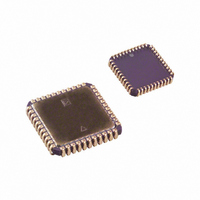AD9058AJJ Analog Devices Inc, AD9058AJJ Datasheet - Page 8

AD9058AJJ
Manufacturer Part Number
AD9058AJJ
Description
IC ADC 8BIT DUAL 50MSPS 44-JLCC
Manufacturer
Analog Devices Inc
Datasheet
1.AD9058AJJ.pdf
(12 pages)
Specifications of AD9058AJJ
Data Interface
Parallel
Rohs Status
RoHS non-compliant
Number Of Bits
8
Sampling Rate (per Second)
50M
Number Of Converters
2
Power Dissipation (max)
960mW
Voltage Supply Source
Analog and Digital, Dual ±
Operating Temperature
0°C ~ 70°C
Mounting Type
Surface Mount
Package / Case
44-JLCC
Resolution (bits)
8bit
Sampling Rate
50MSPS
Input Channel Type
Single Ended
Supply Voltage Range - Analog
± 5V
Supply Current
127mA
Digital Ic Case Style
JLCC
Lead Free Status / RoHS Status
Contains lead / RoHS non-compliant
Available stocks
Company
Part Number
Manufacturer
Quantity
Price
AD9058
AD9058 in through-hole PCB designs, use the AD9058AJD/AKD
with individual pin sockets (AMP Part No. 6-330808-0). Alterna-
tively, surface-mount AD9058 units can be mounted in a
through-hole socket (Circuit Assembly Corporation, Irvine, Cali-
fornia Part No. CA-44SPC-T).
AD9058 APPLICATIONS
Combining two ADCs in a single package is an attractive alterna-
tive in a variety of systems when cost, reliability, and space are
important considerations. Different systems emphasize particular
specifications, depending on how the part is used.
In high density digital radio communications, a pair of high
speed ADCs are used to digitize the in-phase (I) and quadrature
(Q) components of a modulated signal. The signal presented to
each ADC in this type of system consists of message-dependent
amplitudes varying at the symbol rate, which is equal to the
sample rates of the converters.
Figure 5 shows what the analog input to the AD9058 would
look like when observed relative to the sample clock. Signal-to-
noise ratio (SNR), transient response, and sample rate are all
critical specifications in digitizing this “eye pattern.”
Receiver sensitivity is limited by the SNR of the system. For the
ADC, SNR is measured in the frequency domain and calculated
with a Fast Fourier Transform (FFT). The signal-to-noise ratio
equals the ratio of the fundamental component of the signal
(rms amplitude) to the rms level of the noise. Noise is the sum
of all other spectral components, including harmonic distortion,
but excluding dc.
Although the signal being sampled does not have a significant
slew rate at the instant it is encoded, dynamic performance of
the ADC and the system is still critical. Transient response is
ANALOG
ENCODE
ANALOG
SAMPLE
INPUT
D
CLOCK
INPUT
0
–D
7
t
t
t
PD
VALID DATA
A
V
FOR N–1
= DATA DELAY OF PRECEDING ENCODE
= APERTURE TIME
= OUTPUT PROPAGATION DELAY
Figure 5. I and Q Input Signals
N
Figure 4. Timing Diagram
t
A
t
PD
t
V
VALID DATA
FOR N
N+1
CHANGING
DATA
VALID DATA
FOR N+1
N+2
–8–
the time required for the AD9058 to achieve full accuracy when
a step function input is applied. Overvoltage recovery time is the
interval required for the AD9058 to recover to full accuracy after an
overdriven analog input signal is reduced to its input range.
Time domain performance of the ADC is also extremely important
in digital oscilloscopes. When a track-/sample-and-hold is used
ahead of the ADC, its operation becomes similar to that described
above for receivers.
The dynamic response to high frequency inputs can be described by
the effective number of bits (ENOB). The effective number of
bits is calculated with a sine wave curve fit and is expressed as:
where N is the resolution (number of bits) and measured error is
actual rms error calculated from the converter’s outputs with
a pure sine wave applied as the input.
Maximum conversion rate is defined as the encode (sample)
rate at which SNR of the lowest frequency analog test signal
drops no more than 3 dB below the guaranteed limit.
Figure 6. Harmonic Distortion vs. Analog Input Frequency
ENOB
50
40
30
55
45
35
Figure 7. Dynamic Performance vs. Analog Input
Frequency
0.1
60
55
50
45
40
35
30
0.1
=
N
+25 C
−
LOG Error measured Error ideal
INPUT FREQUENCY – MHz
1
INPUT FREQUENCY – MHz
2
1
[
–55 C
(
10
+25 C AND +125 C
10
–55 C
)
+125 C
(
100
100
8.0
7.2
6.4
5.5
REV. D
)
]













